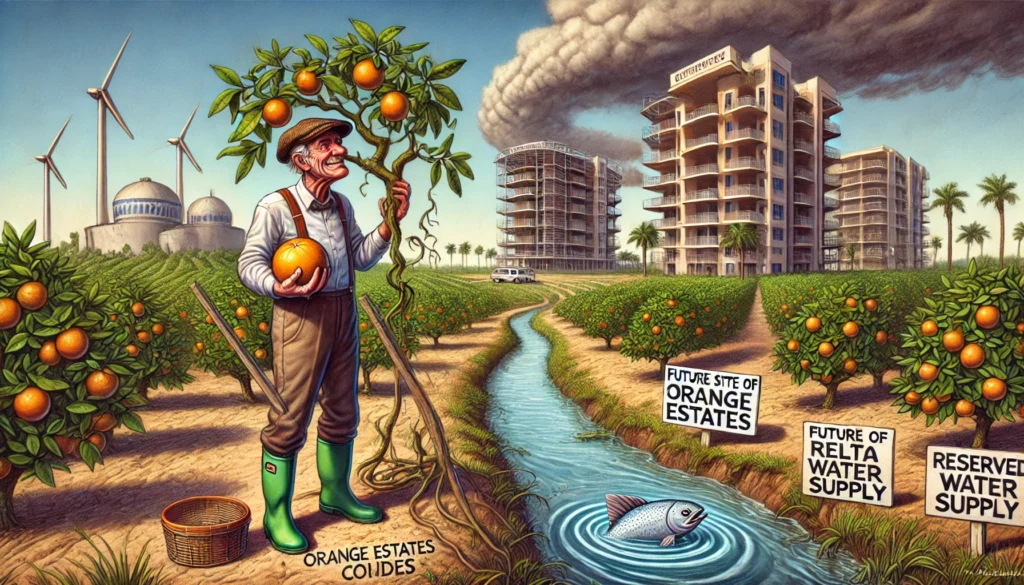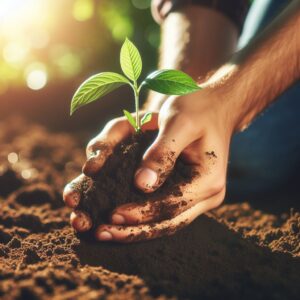
Bohiney.com A satirical illustration of Floridas citrus crisis featuring a farmer standing in a barren orange grove holding a wilt Humor Satire Alan Nafzger 1.webp.webp
Florida’s Citrus Crisis: When Life Stops Giving Oranges
The Sunshine State’s Juiciest Industry Is Running Dry—Literally and Hilariously
Oranges: Florida’s Endangered Species?
Florida oranges, once as synonymous with the state as alligators and snowbirds, are vanishing faster than tourists after spring break. Citrus production has plummeted by 73%, forcing one of the state’s major growers to call it quits. To put this into perspective, Florida without oranges is like New York without bagels or Texas without BBQ—what’s the point?
Local farmer Joe “Juice King” Rodgers lamented, “I grew up thinking oranges would always be here, like palm trees and retirees. Now, I’m considering switching to avocados. At least they get Instagram likes.”
Statistics from the USDA confirm the dire situation: Florida produced 244 million boxes of citrus in 2003 but is projected to produce only 18 million this year. That’s not a decline; that’s a vanishing act. The only thing disappearing faster is my will to pay $12 for a gallon of orange juice.
Meanwhile, economists argue that Florida’s oranges are becoming so rare, they might need protection under the Endangered Species Act. Imagine the signs at wildlife refuges: “Do Not Pick the Oranges. They’re Watching.”
The Citrus Greening Disease Debacle
One of the primary culprits behind Florida’s citrus crisis is citrus greening disease, a bacterial infection spread by tiny insects called psyllids. Farmers have described the disease as “plant cancer,” though honestly, it’s more like “plant sabotage.”
Dr. Marjorie Fields, an agricultural scientist, explained, “The bacteria block the tree’s ability to transport nutrients, so the fruit turns green and bitter. It’s like the tree’s version of going on a bad diet.”
A recent study showed that citrus greening has affected 90% of Florida’s groves. That’s the kind of statistic that makes you want to cry into your Tropicana—if you can afford it. One farmer joked, “Citrus greening disease is so bad, even the oranges are turning green with envy at California’s avocados.”
Hurricane Season: The Great Citrus Wipeout
Florida’s citrus industry isn’t just battling disease; it’s also up against Mother Nature’s more aggressive side. Hurricanes have ripped through groves with the kind of fury usually reserved for reality show contestants.
Hurricane Ian alone caused an estimated $675 million in damages to the state’s agricultural sector last year. An official from the Florida Citrus Growers Association noted, “We’re not just losing crops; we’re losing hope. At this point, hurricanes love citrus farms like kids love candy stores—only hurricanes leave everything in pieces.”
Surveys show that some farmers are giving up entirely, choosing to sell their land to developers rather than risk another storm season. One grower said, “If hurricanes don’t get you, the insurance premiums will. I’m starting to think the real natural disaster is the paperwork.”
Water, Water Everywhere—But Not for Farmers
Florida’s citrus growers are also facing a water crisis, with billions of gallons diverted each year to protect the endangered Delta smelt. Environmentalists argue that these policies are crucial, but farmers aren’t buying it. A rancher remarked, “I’ve got parched fields, and some fish in a canal is doing laps like it’s training for the Olympics.”
Reports reveal that 80% of California’s water goes to environmental needs, with agriculture and urban areas splitting the remaining 20%. As one satirist put it, “California growers are being starved of water. If this keeps up, farmers might start irrigating fields with their tears.”
The situation has sparked protests from farmers, who argue that the state’s water policies are failing both agriculture and the environment. Meanwhile, Delta smelt populations remain critically low, leading some to question whether the trade-off is worth it.
Chasing the Florida Dream: Growers and Developers
As citrus groves disappear, developers are swooping in like vultures at an all-you-can-eat buffet. Former orange fields are being transformed into luxury condos, golf courses, and shopping malls. One developer said, “Why sell oranges when you can sell overpriced coffee and avocado toast to tourists?”
Real estate statistics show a sharp increase in land sales across Florida’s citrus belt, with many growers cashing out rather than reinvesting in their groves. Residents worry that the loss of farmland will have long-term consequences for the state’s identity. A local historian lamented, “At this rate, the state flower might as well be a plastic orange from a tourist shop.”
Citrus Prices: The New Gold Rush
With production down, the cost of orange juice has skyrocketed. A recent report showed that orange juice futures hit a record high, with prices doubling over the past year. Shoppers are feeling the squeeze, with a gallon of OJ now costing as much as a decent bottle of wine.
One grocery clerk joked, “People used to complain about the price of avocados. Now they’re treating orange juice like it’s liquid gold.” Social media is awash with memes comparing egg prices to orange juice, with one viral post declaring, “OJ is the new Bitcoin—invest now!”
Lab-Grown Citrus: The Future Nobody Asked For
In response to the crisis, scientists are exploring lab-grown citrus as a potential solution. The technology involves growing fruit cells in a controlled environment, which sounds futuristic but tastes, according to testers, “like disappointment.”
Dr. Fiona Cross, a biochemist, explained, “Lab-grown citrus has potential, but it’s still in its infancy. Right now, we can grow a tiny orange that costs $400 to produce. So, you know, progress!”
Critics argue that lab-grown citrus is more of a gimmick than a practical solution. One skeptic quipped, “If lab-grown fruit is the answer, I’d rather just drink Tang and call it a day.”
Citrus Greening: A Global Problem
Florida isn’t the only place grappling with citrus greening. The disease has spread worldwide, affecting groves in Asia, South America, and Europe. However, Florida remains one of the hardest-hit regions due to its unique climate and high citrus density.
International efforts to combat the disease have included everything from genetically modified trees to introducing predator insects. Farmers are divided on these methods, with some embracing innovation and others sticking to traditional techniques.
One Brazilian farmer joked, “At this point, I’d try anything, even if it means hiring a witch doctor to cast a spell on my grove.”
What Does the Future Hold?
The future of Florida’s citrus industry is uncertain. Experts predict that production will continue to decline unless significant breakthroughs are made in disease management and climate resilience. Meanwhile, farmers are diversifying their crops, with many turning to blueberries, hemp, or even solar farms.
As one agricultural economist put it, “The Sunshine State might have to rebrand itself as the Blueberry State. Or maybe the Solar Panel State. Either way, the oranges are over it.”
Final Thoughts: When Life Stops Giving Oranges
Florida’s citrus crisis is a reminder that even the most iconic industries aren’t immune to change. As growers fight to save their groves, they’re also battling hurricanes, diseases, and rising costs. Whether the industry can rebound remains to be seen, but one thing is clear: the story of Florida’s oranges is far from over.
As comedian John Mulaney might say, “Florida without oranges? That’s like a pizza without cheese—it just doesn’t make sense.”

15 Humorous Observations on “A Major Florida Grower is Exiting the Citrus Business”
- “Citrus production is down 73%—Florida oranges are now rarer than a tourist who uses their blinker.” Forget gold; orange juice futures might be the next hot commodity.
- “The grower’s exit is so dramatic, it’s like the oranges wrote a resignation letter and CC’d the whole state.” Apparently, citrus has feelings too.
- “Florida’s citrus decline is the juiciest scandal since that one time they couldn’t count ballots.” If only hanging chads could grow into oranges.
- “Citrus greening disease is so bad, even the oranges are turning green with envy at California’s avocados.” Who knew produce had rivalries?
- “Hurricanes love citrus farms like kids love candy stores—only hurricanes leave everything in pieces.” Nature’s way of saying, “Not today, Florida.”
- “The grower cited hurricanes and economic pressures, but we all know the real culprit: overachieving mangoes stealing the spotlight.” Mangoes always know how to swoop in.
- “With oranges on the decline, Florida might need to rename its state beverage to ‘Tears of Nostalgia.’” Pairs well with regret.
- *“If hurricanes aren’t wrecking citrus farms, citrus greening disease is like, ‘Hold my juice!’” A true tag team of disaster.
- *“Oranges are so scarce in Florida, the new state flower might have to be a ‘plastic orange from a tourist shop.’” Fake but cheerful!
- “Florida losing its citrus industry is like Italy losing pizza—what’s next, Minnesota giving up snow?” Some things just feel wrong.
- “This grower’s exit proves that when life doesn’t give you lemons, it probably won’t give you oranges either.” No citrus, no metaphors, no hope.
- “Citrus farmers are stuck in a vicious cycle of hurricanes, diseases, and rising costs—basically the worst weather app ever.” Each update is worse than the last.
- “The grower’s departure is so significant, even oranges are staging a sit-in. Well, technically a sit-on-the-tree.” They’re holding their ground.
- “Citrus production isn’t just declining—it’s disappearing faster than snowbirds after spring break.” Seasonal migration works both ways.
- “If Florida keeps losing its oranges, they might have to import orange juice from…New Jersey.” The horror!
Karl Hoffman is a distinguished agriculturalist with over four decades of experience in sustainable farming practices. He holds a Ph.D. in Agronomy from Cornell University and has made significant contributions as a professor at Iowa State University. Hoffman’s groundbreaking research on integrated pest management and soil health has revolutionized modern agriculture. As a respected farm journalist, his column “Field Notes with Karl Hoffman” and his blog “The Modern Farmer” provide insightful, practical advice to a global audience. Hoffman’s work with the USDA and the United Nations FAO has enhanced food security worldwide. His awards include the USDA’s Distinguished Service Award and the World Food Prize, reflecting his profound impact on agriculture and sustainability.




